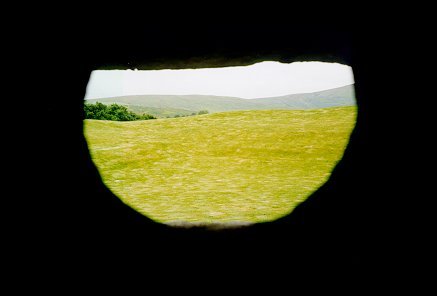Hermitage Castle
Feb 20th, 2008 | By admin | Category: Photo HistoryHermitage Castle resides in the small valley of the Hermitage Water in Liddesdale, that turbulent Reiver infested haunt. The name is said to derive from a holy man whom lived within the valley long before the castle was ever built. What that holy man would make of the ruin which stands even today is questionable. Hermitage Castle, though small in comparison to such examples as Cearnarvon and Edinburgh, dominates the landscape with a menacing and determined stance. It looks on with a malice far exceeding its size and yet unquestioning in it threat. Hermitage inspires thoughts of dragons and wizards conjured from ones childhood, and dark deeds done in the dead of night. The castles stark presence has inspired many legends, including that of Lord de Soulis and his wicked wizardry and his ultimate demise in a cauldron of boiling lead.Hermitage itself needs no myth nor legends to heighten its historic past. Due to its strategic position the castle has always been central to much of the surrounding border history.

Its position marks it as a key point in guarding the often bloody border area. Built in around 1240, probably by Sir Nicholas de Soules, the Kings butler, the original castle on the present site, would probably have been of timber motte-and-bailey construction. Later this was replaced by a stone castle first built by the English Lord Dacre, with later additions by the Scottish Noble families of Douglas and Angus. Later in its history the Earls of Bothwell came into possession of the Castle, the most infamous of which saw the illicit, and highly romanticised visit of the then married Mary Queen of Scots in 1566.
In truth the visit was not so romantic. On the 8th October 1566 Bothwell was injured during a skirmish with a particularly noted Reiver, one Little John Elliot of the Park. Mary, whom at the time was on an annual progress from Edinburgh, was resident in Jedburgh. On hearing of Bothwell’s injury, Mary, who married to Lord Darnley, and an entourage of servants whose purpose was to protect her reputation as much as her person, rode to Hermitage Castle. There were already rumours abound which linked the two, and such a fleeting visit would only serve to heighten them. As Mary was married there was never the option to stay at Hermitage, and the whole party made their return journey to Jedburgh. During the 25 mile trek Mary stumbled into a bog, contracted a fever and was bed-bound in Jedburgh for a week.
By 1594 Hermitage was in the hands of one of the most notable Reivers, Sir Walter Scott of Branxholm and Buccleuch. The Bold Buccleuch, as he is popularly known is possibly most famous for his part on in the rescue of another infamous Reiver, Kinmont Willie Armstrong from Carlisle Castle in 1596.
The Exploits of the Bold Buccleuch were to be the final chapters in the long standing history of Hermitage Castle. In 1603, Hermitage Castle was to bear witness to the radical changes resulting from the Union of the Crowns and the ascension of James VI of Scotland as James I of England.

The first picture of Hermitage Castle shows the castle from the north west with the central tower flanked by the prison tower (left) and the north west and kitchen towers (right). The original entrance (not visible) to the castle was at first floor level just to the right of the high pointed arch. The progressive changes that the castle went through are also visible within the photographs. Clearly visible on the photograph below is one of the later additions to many castles, a gun-hole. The broad gun-hole allows a wider field of fire, unlike the narrow arrow-slits they replaced. This can be seen by the north facing view in the second photograph displaying the potential line-of-sight offered.


this is a great place to visit and steeped in history well worth it. took some fab pics myself. forboding in winter months and in summer daylight . value for money . love the site too